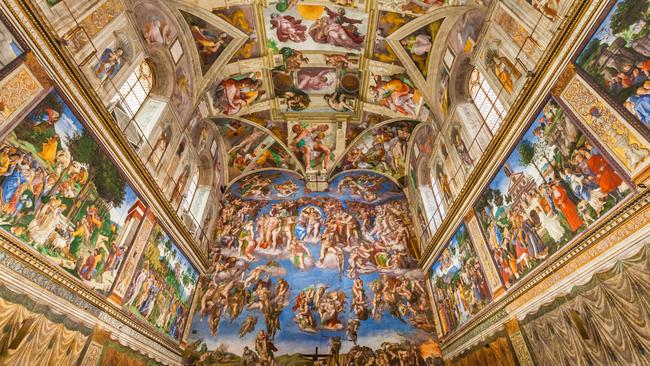Vatican City: Michelangelo’s hidden tribute to Mary Magdalene
An Italian author says the woman who followed Christ to the end is in a Sistine Chapel fresco.

Half hidden behind a crucifix, the woman with flowing blonde hair and a wild stare is easy to miss amid the crowd of 300 saints and sinners in Michelangelo’s The Last Judgment.
Each year, five million people squint up at the sprawling fresco that graces the end wall of the Sistine Chapel in the Vatican, yet most focus on Christ welcoming the worthy into paradise as wrongdoers are dragged down to hell.
However, according to new research, there, in the thick of it all, is a key biblical figure who has not been spotted down the centuries: Mary Magdalene, the woman who faithfully followed Jesus to the end and earned the title “apostle of apostles”.
“The Sistine Chapel covers everything, from Genesis to the Apocalypse – how is it possible that Mary Magdalene is not here?” says Sara Penco, the author of the new book Mary Magdalene in Michelangelo’s Judgement.
Penco points to the mysterious figure’s blonde hair and yellow clothing, typical of depictions of Mary Magdalene in art that Michelangelo Buonarroti would have known in the 16th century. She appears to be kissing a crucifix, which Penco linked to her role in the Bible as a witness to Jesus’s crucifixion and resurrection.
Depicted as a wealthy woman, Mary supported Christ after he performed an exorcism on her, driving out seven demons.
She was also central to Dan Brown’s 2003 thriller The Da Vinci Code, which suggests she had a child with Jesus.
“Vittoria Colonna, a woman Michelangelo loved, urged upon him the importance of Mary Magdalene,” said Penco, whose theories have been backed by Yvonne Dohna Schlobitten, a professor at the Vatican’s Gregorian University in Rome.
Crucial to Penco’s hypothesis is the muscular, near-naked man appearing to shoulder the cross that she is kissing. Often thought to be Simon of Cyrene, who was forced by the Romans to carry Jesus’s cross, Penco said the figure was Christ himself, which would mean the fresco has not one but two depictions of Jesus. “The figure … in the centre is Christ the judge, while the second with the cross is Christ the redeemer,” she said, noting that both men have similar facial features and the same raised arm. “The Christ with the cross is looking straight at Mary Magdalene.”
Penco said paintings of The Last Judgment with two Christs were not uncommon, pointing to a 12th-century example owned by the Vatican.
Antonio Natali, an expert on Michelangelo and the former director of the Uffizi gallery in Florence, said it was true that Mary Magdalene had often been painted with blonde hair and wearing yellow, but not always. “In Raphael’s Deposition, for example, she is wearing red,” he said.
The latest research on The Last Judgment follows years of guessing games about who Michelangelo included in the fresco, which he started in 1536, 25 years after finishing his series of biblical scenes on the ceiling of the Sistine Chapel.

The clean-shaven Jesus, which broke from the standard bearded depiction of Christ, was thought to have been inspired by an ancient Greek statue of Apollo that had recently been acquired by Pope Julius II. The face on the flayed skin torn from the body of the martyr St Bartholomew is believed to be a self-portrait of Michelangelo. At the bottom of The Last Judgment, the mythological figure Minos, who oversees the entry of the damned into Hell, bears a resemblance to Biagio da Cesena, a papal master of ceremonies and contemporary critic of Michelangelo.
During a visit to the Sistine Chapel to see the half-completed work, Da Cesena reportedly told the Pope it was “disgraceful that in so sacred a place there should have been depicted all those nude figures, exposing themselves so shamefully, and that it was no work for a papal chapel but rather for the public baths and taverns”.
Michelangelo apparently reacted by giving Minos Da Cesena’s features, donkey’s ears, and wrapping a coiled snake around him. During later restoration work, it was discovered the snake was biting Da Cesena’s genitals. When he complained, the Pope famously replied that he could do nothing about it because his jurisdiction did not extend to Hell.
For a fresco adorning the chapel in which popes are elected, The Last Judgment quickly prompted criticism from Vatican bigwigs over the number of muscular, naked men it contained, which were a clue to Michelangelo’s sexual tastes.
Look closely at the crowd of do-gooders heading for paradise and a male couple appear to be kissing.
Researchers have speculated that the artist drew inspiration from the burly manual workers and porters he saw in Rome’s 16th-century bath houses, where both male and female prostitution was a feature.
It all proved too much for the Vatican, which ordered the artist Daniele da Volterra to cover up the dangling genitalia after Michelangelo’s death, earning him the nickname “Il Braghettone” or “the breeches maker”.
The artist was also asked to repaint St Blaise, an Armenian bishop in The Last Judgment, who appeared to be staring at St Catherine’s naked behind.
THE TIMES



To join the conversation, please log in. Don't have an account? Register
Join the conversation, you are commenting as Logout